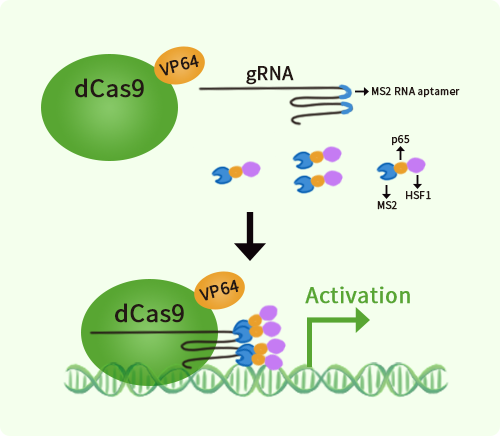Human ABCG2 activation kit by CRISPRa
CAT#: GA106296
ABCG2 CRISPRa kit - CRISPR gene activation of human ATP binding cassette subfamily G member 2 (Junior blood group)
Find the corresponding CRISPRi Inhibitor Kit
USD 1,657.00
2 Weeks*
Specifications
| Product Data | |
| Format | 3 gRNAs (5ug each), 1 scramble ctrl (10ug) and 1 enhancer vector (10ug) |
| Symbol | ABCG2 |
| Locus ID | 9429 |
| Kit Components | GA106296G1, ABCG2 gRNA vector 1 in pCas-Guide-GFP-CRISPRa GA106296G2, ABCG2 gRNA vector 2 in pCas-Guide-GFP-CRISPRa GA106296G3, ABCG2 gRNA vector 3 in pCas-Guide-GFP-CRISPRa 1 CRISPRa-Enhancer vector, SKU GE100056 1 CRISPRa scramble vector, SKU GE100077 |
| Disclaimer | These products are manufactured and supplied by OriGene under license from ERS. The kit is designed based on the best knowledge of CRISPRa SAM technology. The efficiency of the activation can be affected by many factors, including nucleosome occupancy status, chromatin structure and the gene expression level of the target, etc. |
| Reference Data | |
| RefSeq | NM_001257386, NM_004827, NM_001348985, NM_001348986, NM_001348987, NM_001348988, NM_001348989 |
| UniProt ID | Q9UNQ0 |
| Synonyms | ABC15; ABCP; BCRP; BCRP1; BMDP; CD338; CDw338; EST157481; GOUT1; MRX; MXR; MXR1; UAQTL1 |
| Summary | The membrane-associated protein encoded by this gene is included in the superfamily of ATP-binding cassette (ABC) transporters. ABC proteins transport various molecules across extra- and intra-cellular membranes. ABC genes are divided into seven distinct subfamilies (ABC1, MDR/TAP, MRP, ALD, OABP, GCN20, White). This protein is a member of the White subfamily. Alternatively referred to as a breast cancer resistance protein, this protein functions as a xenobiotic transporter which may play a major role in multi-drug resistance. It likely serves as a cellular defense mechanism in response to mitoxantrone and anthracycline exposure. Significant expression of this protein has been observed in the placenta, which may suggest a potential role for this molecule in placenta tissue. Multiple transcript variants encoding different isoforms have been found for this gene. [provided by RefSeq, Apr 2012] |
Documents
| Product Manuals |
| FAQs |
| SDS |
Resources
Other Versions
| SKU | Description | Size | Price |
|---|---|---|---|
| KN205640 | ABCG2 - human gene knockout kit via CRISPR, HDR mediated |
USD 1,657.00 |
|
| KN205640BN | ABCG2 - human gene knockout kit via CRISPR, HDR mediated |
USD 1,657.00 |
|
| KN205640LP | ABCG2 - human gene knockout kit via CRISPR, HDR mediated |
USD 1,657.00 |
|
| KN205640RB | ABCG2 - human gene knockout kit via CRISPR, HDR mediated |
USD 1,657.00 |
|
| KN405640 | ABCG2 - KN2.0, Human gene knockout kit via CRISPR, non-homology mediated. |
USD 1,657.00 |
{0} Product Review(s)
Be the first one to submit a review






























































































































































































































































 Germany
Germany
 Japan
Japan
 United Kingdom
United Kingdom
 China
China
